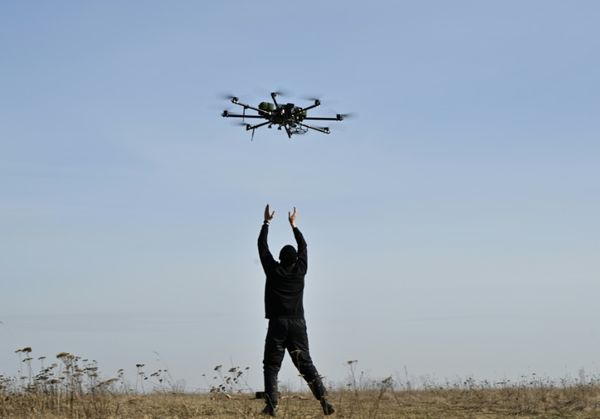
Geoffrey Standing Bear, chief of the Osage Nation, is about to get changed into his tuxedo, bow tie and traditional blanket for the London premiere of Killers of the Flower Moon. This will be the fifth time he’s seeing the three-and-a-half-hour movie, he says. “You need to see it more than once to get the depth.” Mind you, the second time, at the Cannes film festival, he couldn’t really pay attention. “It was hard to concentrate on the film because I was always looking at famous people,” he says, laughing. Like who? “I saw Cate Blanchett, you know, who played Galadriel [in The Lord of the Rings movies]. She was right there. I just wanted to go up to her and say, ‘Hey, do you have an elven gift for me?’ But I thought I better be quiet, I’m gonna embarrass people. But, you know, I’m sitting next to Robert De Niro – that’s pretty famous.”
Chief Standing Bear, a serene, healthy-looking man of 70, seems to be enjoying his detour into showbiz, but few people can have had firmer grounds for suspicion than the Osage Nation when Hollywood came knocking at the door. In the broad sense, American film and television have not been renowned for sensitive portrayals of Native Americans. Having already suffered the apocalyptic invasion of European settlers, Native Americans spent much of the last century seeing their history reconfigured as entertainment, invariably with themselves as the bad guys.

In addition, the Osage have particular, historic reasons to distrust outsiders, as victims of one of the worst American crimes of the 20th century, at the hands of greedy white people. Now known as “the reign of terror”, it is a saga so brazenly evil it is almost impossible to fathom, combining institutional deceit, economic exploitation, blithe racism and calculated mass murder.
Ironically or fortuitously, this was precisely the story Hollywood was seeking to tell. Adapted from David Grann’s bestselling nonfiction book, Killers of the Flower Moon, Martin Scorsese’s film lays out this grim true story in epic, authentic detail. It plays like the dying breath of the Old West, as it gives way to a different breed of 20th-century lawlessness, accompanied by the advent of the FBI (this was one of its first major cases), and will leave most viewers wondering how this episode in history could have remained untold for so long.
The Osage know the story only too well, of course. In 1872, having been displaced several times over the preceding centuries, the tribe took the rare step of purchasing a reservation: nearly 1.5m acres of nondescript land in northern Oklahoma – which happened to contain a vast reservoir of oil. The Osage had shrewdly retained the mineral rights to the land, which they decreed could only be inherited and not sold. So, for a brief period in the 1920s, they became, per capita, the richest people on the planet, with power to purchase grand homes and fancy cars, and employ white servants. But as one Osage elder puts it in the movie, “When this money started coming, we should have known it came with something else.”
Scorsese’s story focuses on the real-life figure of William “King” Hale (De Niro), a white cattle rancher who befriended the Osage, even as he masterminded an elaborate plot to gain control of their wealth. To this end, he encouraged his nephew, Ernest Burkhart (Leonardo DiCaprio), to charm and marry an Osage woman, Mollie Kyle (Lily Gladstone, who is Native American but not Osage). Contradictory as it seems, there was an element of genuine love to their relationship, the story suggests, even as Burkhart assisted Hale in murdering the rest of Kyle’s family. This is just one of many strands to the Reign of Terror – more than 100 Osage are thought to have been murdered altogether, and most of the crimes remain unsolved.
Compounding the injustice was a federal ruling that the Osage were not allowed to control their own oil wealth directly. Instead, each was appointed a white “guardian”, who would manage their accounts. Inevitably the guardians skimmed off huge amounts for themselves. “I talked to one woman who said when she was a girl, she went to the merchant store with her grandparents every three months and she just handed a cheque to the merchant who told them, ‘You can fill your truck up with anything in the store.’ And then he gave them back some paper currency. We don’t know how much that cheque was for. We don’t know how much that currency was,” says Standing Bear.
The whole white population seems to have been in on it, from the doctors who prescribed poisoned insulin under the guise of diabetes treatment to the coroners who covered up murders to the federally ordained Bureau of Indian Affairs.
“It’s not, who was complicit? It’s who wasn’t complicit?” says Standing Bear. This tragedy is almost within living memory, he stresses. “It was the time of our grandparents. My grandmother lived to be 90. She was born in 1900, so she was 21, 22, 23 when all this was going on. She had a really good memory about all that when I was growing up, but she and her contemporaries just didn’t want to talk about it a lot. We all knew about it, but it wasn’t until the last 20 years that we started really talking about it more openly.”

All of this left Scorsese and his team with a great deal of distrust to overcome. “When they struck oil on Osage land, the majority of people trusted in the Bureau of Indian Affairs. And because of this trust, the system took advantage of them on such a massive scale,” says Scorsese. “I explained that, for me, it was crucial to establish trust with the community.”
He first met Standing Bear and the Osage community in 2019. “The intention was to just start off with an informal visit, getting to know each other. We wound up talking for quite a while, about a wide range of topics.” They talked about spirituality, Scorsese recalls, Osage and Christian. “I had just made Silence, which I later sent him to watch. He thought that the Jesuits were very clever, because of the way they blended Christianity with Osage spiritual beliefs.”
Standing Bear was familiar with Scorsese movies such as Taxi Driver, Goodfellas and Gangs of New York, but less so his “cultural movies” such as Silence and Kundun. His initial priorities were that Scorsese make the movie on location and incorporate genuine Osage culture: “Our language, our culture – and not to include other tribal ways. We respect other tribal ways, but we have our own. And even among ourselves, just to keep our traditions going day to day, month to month, year to year is tough.”
Almost the first thing Scorsese said to him was, “‘We’re going to film here,’” says Standing Bear. “And so from there on, that door kept opening. I introduced him to our people.” After that first meeting, there was a dinner with about 100 Osage tribal members, who spoke of their memories of the Reign of Terror. At the end, Scorsese went around and shook the hands of every person.

“It was a good start, and a fruitful one,” says Scorsese. “The most important thing to me was to get across the fact that I was not going to make a picture in which a few Osage would just be victims in the background, that we were approaching the project in a very different spirit. I think that Chief Standing Bear understood that.”
Many of the Osage community, which today numbers about 25,000, became involved in making the film; a whole 1920s landscape was mocked up – dirt roads, wooden shop fronts, saloon bars, even a steam locomotive. “There were about 100 Osages that were selected as extras,” says Standing Bear. “We had people working with cinematographers, sets, costumes, so that they received some financial benefit and, for some of them, find some opportunities in the business, which they still are following. Also to have an experience of a lifetime. Because they filmed for six months straight. And they just 24/7 were living in that world.”
But, Scorsese stresses: “The most important thing to remember is that while the story is set in the 1920s, it’s not a ‘historical’ film. What I mean by that is, that the effects of the tragedy are still felt within the community.”
The racist “guardianship” system was not overturned until 1978 and, today, only 6,000 Osage retain any oil rights. “We estimate 1.5bn barrels have been removed from our lands in all this time,” says Standing Bear, who worked as a lawyer for 30 years. “We’ve finally received some compensation for lack of accounting of some of this money, but all the big issues still remain. I’ve seen some shifts in federal policy to provide more respect for tribal self-governance but, in reality, in the economics of building proper infrastructure, schools, health, we lag far behind.” The Osage continue to be susceptible to sugar-related diseases, he says, such as alcoholism and diabetes. “I’ve had cousins, second cousins, where it went beyond just taking treatment for diabetes, they had amputations and they eventually died. And they were young, in their 30s and 40s.”
Killers of the Flower Moon is at least a sign that the tide could be turning, both in terms of willingness to revisit shameful aspects of America’s history, and in screen portrayals of Native Americans. In recent years, for example, we’ve had Sterlin Harjo’s sitcom Reservation Dogs, centred on four indigenous teenagers in modern-day Muscogee, Oklahoma (only a couple of hours’ drive from Osage County). We’ve had rounded, up-to-date Native American characters portrayed in films such as Chloé Zhao’s Songs My Brothers Taught Me (set on a Lakota Sioux reservation) and Kelly Reichardt’s Certain Women (which provided a breakout role for Lily Gladstone as a rancher with feelings for Kristen Stewart). We’ve had the revisionist western series The English with Chaske Spencer as a Native American hero, opposite Emily Blunt. We’ve even had Prey, an action-packed alien-invasion prequel to the Predator films, set among an 18th-century Comanche tribe.

Perhaps culture can move the conversation on but not even Scorsese would claim it can heal the wounds of history. “Art can affect us on a very deep, very mysterious level,” he says. “I’ve felt it myself and I’ve seen it in others. Certain pictures I’ve seen, some many times, are more than great movies – they are genuine revelations. I don’t know if they put things right, but they widen our field of vision, our sense of what it is to be alive. It’s what I’ve always responded to and what I’ve always aspired to.”
As much as Killers of the Flower Moon pulls the Osage Nation’s tragic history out of the shadows, it also reminds them of what they have suffered, says Standing Bear. “I didn’t realise when I was watching the movie that I, personally, have failed in being fully sympathetic to these families who did lose people. What must they be going through when they see this movie, and see their grandfather shot in the back of the head on the big screen? Or when they see the large family groups of cousins and aunts and uncles at our ceremonies, and think ‘My family, we’re small. We should have been as large as anybody else’s, but our people were all murdered.’ I never thought of that aspect of it. This movie’s brought out such things, and that’s painful. So yeah, this story is something for all of us to learn from.”
• Killers of the Flower Moon is in cinemas from October 20







